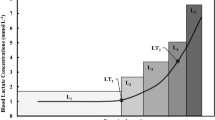Abstract
The diving response is the sequence of cardiovascular, respiratory and metabolic adjustments produced by apnoea and further strengthened by cooling of the facial area and/or hypoxia. This study aimed at comparing the cardiovascular response to diving of trained divers with that of a control group. In this order, 14 trained divers were compared with 14 non-divers. By means of impedance cardiography and continuous monitoring of arterial pressure, hemodynamic data were collected during three different experimental sessions. Each session included a cycle-ergometer exercise against a workload of 0.5 W kg−1 of body mass, pedalling in a steady-state condition. During exercise, each subject randomly accomplished 40 s of breath-hold exercise with face immersion (test A) or in air (test B). A control exercise test with normal breathing (test C) was also performed. Divers showed a faster onset of bradycardic response (ANOVA, P < 0.01) and a faster adjustment in systemic vascular resistance (P < 0.001 for divers vs. controls) than did non-divers. Moreover, cardiac output decreased only in divers during the first phase of test A (P < 0.01 for divers vs. controls). The most striking findings were that divers showed a more rapid cardiovascular adjustment with respect to controls, in particular in heart rate and systemic vascular resistance; moreover, with continued apnoea, a delayed increase in myocardial performance and stroke volume occurred and obscured the cardiovascular effects of the diving response.








Similar content being viewed by others
References
Andersson JPA, Linér MH, Rünow E, Schagatay EK (2002) Diving response and arterial oxygen saturation during apnea and exercise in breath-hold divers. J Appl Physiol 93:882–886
Andersson JPA, Linér MH, Fredsted A, Schagatay EK (2004) Cardiovascular and respiratory responses to apneas with and without face immersion in exercising humans. J Appl Physiol 96:1005–1010
Bjertnæs L, Hauge A, Kjekshus J, Søyland E (1984) Cardiovascular responses to face immersion and apnea during steady state muscle exercise. Acta Physiol Scand 120:605–612
Concu A, Marcello C (1993) Stroke volume response to progressive exercise in athletes engaged in different types of training. Eur J Appl Physiol 66:11–17
Crisafulli A, Melis F, Orrù V, Lener R, Lai C, Concu A (2000) Hemodynamics during a postexertional asystolia in healthy athlete: a case study. Med Sci Sport Exerc 32:4–9
Crisafulli A, Orrù V, Melis F, Tocco F, Concu A (2003a) Hemodynamics during active and passive recovery from a single bout of supramaximal exercise. Eur J Appl Physiol 89:209–216
Crisafulli A, Scott AC, Wensel R, Devos CH, Francis DP, Pagliaro P, Coatts AJS, Concu A, Piepoli MF (2003b) Muscle metaboreflex-induced increases in stroke volume. Med Sci Sports Exerc 35:221–228
Crisafulli A, Salis E, Pittau G, Lorrai L, Tocco F, Melis F, Pagliaro P, Concu A (2006) Modulation of cardiac contractility by muscle metaboreflex following efforts of different intensities in humans. Am J Physiol Heart Circ Physiol 291:H3035–H3042
Daly MD, Angell-James JE, Elsner R (1979) Role of carotid-body chemoreceptors and their reflex interactions in bradycardia and cardiac arrest. Lancet 1(8119):764–767
Ferretti G (2001) Extreme human breath-hold diving. Eur J Appl Physiol 84:254–271
Ferretti G, Costa M (2003) Diversity in and adaptation to breath-hold diving in humans. Comp Biochem physiol part A 136:205–213
Ferrigno M, Ferretti G, Ellis A, Warkander D, Costa M, Cerretelli P, Lundgren CEG (1997) Cardiovascular changes during deep breath-hold dives in a pressure chamber. J Appl Physiol 83:1282–1290
Foster GE, Sheel AW (2005) The human diving response, its function, and its control. Scand J Med Sci Sports 15:3–12
Lin YC (1988) Appl Physiol diving. Sports Med 5:41–56
Lindholm P, Lundgren CE (2009) The physiology and pathophysiology of human breath-hold diving. J Appl Physiol 106(1):284–292
Lindholm P, Sundblad P, Linnarsson D (1999) Oxygen-conserving effects of apnea in exercising man. J Appl Physiol 87(6):2122–2127
Lindholm P, Nordh J, Linnarsson D (2002) Role of hypoxemia for the cardiovascular responses to apnea during exercise. Am J Physiol Regul Integr Comp Physiol 283(5):R1227–R1235
Manley L (1990) Apnoeic heart rate responses in humans. A review. Sports Med 9(5):286–310
Marabotti C, Scalzini A, Cialoni D, Passera M, L’Abbate A, Bedini R (2009) Cardiac changes induced by immersion and breath-hold diving in humans. J Appl Physiol 106:293–297
Nelesen RA, Dimsdale JE (2002) Use of radial arterial tonometric continuous blood pressure measurement in cardiovascular reactivity studies. Blood Press Monit 7:259–263
Schagatay EK, van Kampen M, Emanuelsson S, Holm B (2000) Effects of physical and apnea training on apneic time and the diving response in humans. J Appl Physiol 82:161–169
Stewart IB, Bulmer AC, Sharman JE, Ridgway L (2005) Arterial oxygen desaturation kinetics during apnea. Med Sci Sports Exerc 37(11):1871–1876
Sundblad P, Linnarsson D (1996) Influence of apnea on cardiovascular responses to neck suction during exercise. Am J Physiol 271(4 Pt 2):H1370–H1374
Tanaka K, Yoshimura T, Sumida S, Mitsuzono R, Tanaka S, Konishi Y, Watanabe H, Yamada T, Maeda K (1986) Transient responses in cardiac function below, at, and above anaerobic threshold. Eur J Appl Physiol 55:356–361
Acknowledgments
The authors are grateful to the Instructors of Apnoea Academy Mr. Michele Avaro and Mr. Roberto Mattana for their suggestions and help which were essential for the realisation of this study. The University of Cagliari and Banco di Sardegna Foundation supported this study.
Author information
Authors and Affiliations
Corresponding author
Additional information
Communicated by Dag Linnarsson.
Rights and permissions
About this article
Cite this article
Tocco, F., Crisafulli, A., Melis, F. et al. Cardiovascular adjustments in breath-hold diving: comparison between divers and non-divers in simulated dynamic apnoea. Eur J Appl Physiol 112, 543–554 (2012). https://doi.org/10.1007/s00421-011-2006-0
Received:
Accepted:
Published:
Issue Date:
DOI: https://doi.org/10.1007/s00421-011-2006-0




